Gamification in IT Service Management: A Systematic Mapping Study
Abstract
1. Introduction
2. Related Work
2.1. Gamification in Software Engineering Processes
2.2. Gamification in Education and Learning
3. Research Methodology
3.1. Research Questions
3.2. Search Process
3.3. Study Selection
3.4. Data Extraction and Analysis
4. Results
4.1. General Results
4.2. RQ1. What Issues of ITSM Process Implementation Have Been Addressed through Gamification?
- (a)
- Motivation and Engagement
- (b)
- Process Learning
- (c)
- Key Performance Indicators (KPIs) of Process
- (d)
- User Behavior
4.3. RQ2. In Which Scope of ITSM Has Gamification Been Implemented?
4.3.1. RQ2.1. Which ITSM Frameworks and Standards Have Been Used as References in the Gamification Proposals?
4.3.2. RQ2.2. Which ITSM Processes Have Been Addressed by Gamification?
- (a)
- No Specific Process
- (b)
- IT Service Support and IT Service Incident Management Processes
- (c)
- IT Service Capacity Management Process
- (d)
- IT Service Transition Processes
4.4. RQ3. How Has Gamification Been Implemented in ITSM Processes?
4.4.1. RQ3.1. Which Methods or Frameworks Have Been Used to Gamify ITSM Processes?
- [P01]: The authors proposed a method to gamify ITSM support processes that integrates ITIL [11] and a process gamification framework that the authors also designed. The first activity of the method is a Feasibility study whose purpose is to identify the benefits of gamifying support processes. Next, the activity of Analysis focuses on determining the actual state of the support processes and collecting the stakeholder’s needs. The third activity, Design, aimed to identify and prepare the services, and to define the game elements that will be integrated in the support processes. The objective of the fourth one, Testing, is to ensure that the design complies with the requirements of the gamified process. Then, the activity of Implementation contains tasks to incorporate the game elements into the process, to perform tests of the gamified process, to configure the IT infrastructure, to make the user guide, and to perform a training workshop. Finally, the activity Monitoring and Evaluation focuses on ensuring support processes run properly, asking user’s opinion, reviewing the feedback and conducting the gap analysis. In [P04], Raflesia and Kridanto applied the method they proposed in [P01] to develop a gamified service desk prototype. Besides, in [P04] and [P12] they presented application cases of that service desk prototype to illustrate the positive impact that gamifying the service desk has on the engagements of the service desk agents, the service quality and the success of ITIL support processes adoption.
- [P02]: The authors introduced a conceptual framework for the enhancement of ITSM processes based on simulation modeling and gamification. Unlike the method proposed in [P01], the conceptual framework presented in [P02] can be applied in the context of any ITSM process. The main activities of the conceptual framework are the next three: (1) to define the organization’s process, (2) to build a process simulation model and (3) to gamify the simulation model experimentation, for which a methodology is also proposed [P02]. The authors used both ITIL recommendations and the gamification procedure proposed by Werbach and Hunter [32] as a guideline to design their framework. Next, we summarize the main steps of the proposed gamification methodology. The purpose of the first activity, Define business objectives, is to motivate IT managers for performing model simulations and addressing IT manager behaviors through model simulations. Then, the activity Determine target behaviors focuses on identifying the behaviors to promote in IT managers (e.g., carry out model simulations by varying the process configurations) and defining adequate metrics to evaluate these behaviors (e.g., amount of model simulations conducted with diverse process configurations). The aim of the third activity, Design activity cycles, is to define the actions and simulations that IT managers would have to perform (e.g., perform model simulations with an initial process configuration) and to group them into progression levels (four levels). Next, to make the gamified system more fun (activity Incorporate fun) the authors proposed to include a game to find a treasure into the activity of simulation model experimentation. The last activity, Deploy appropriate tools, is centered on determining the game elements to include in the model simulations and to implement them. [P02] also presented an application case of the proposed conceptual framework for improving the ITIL capacity management process.
- [P08]: The authors of [P02] presented in [P08] a method for gamifying the IT service incident management that was designed considering ITIL recommendations and adapting the gamification framework proposed by Werbach and Hunter [32] to the particularities of this process. The first activity consists of identifying the incident management problems to address through gamification. The authors propose to identify the objectives to meet and the critical factors for the success of the incident management process (CSFs) (e.g., resolve the incidents as quickly as possible). Likewise, KPIs associated to the CSFs will be defined (e.g., average incident resolution time and amount/percentage of incidents resolved remotely). The following activity consists of determining the behaviors of the support group agents (e.g., to record new incidents, to determine the category and percentage of the incident, and to resolve the incident within response times set). The purpose of the third activity is to characterize the agents of the support groups (users of the gamified system in this case). The authors suggest interviewing support group agents, and to observe and measure their actual behaviors to identify their needs and motivations, and to determine their behavior in the process. After that, engagement loops will be defined to conduct the actions of the support group agents through the process. The main objective of this step is that support group agents manage adequately the incidents to fulfill the agreed service level agreements. Finally, to make the job of support group agents more enjoyable, the most adequate game elements will be selected and implemented in an incident management tool. To illustrate the utility and applicability of the gamification method proposed, [P08] presented an example of use to gamify the IT service incident management process in a hypothetical company.
4.4.2. RQ3.2. What Game Elements Have Been Included in the Gamified ITSM Processes?
- (a)
- Game Dynamics
- (b)
- Game Mechanics
- (c)
- Game Components
4.4.3. RQ3.3 What Tools or Platforms Have been Used to Implement the Gamified ITSM Processes?
4.4.4. RQ3.4. Who are the Participants in the Gamification Proposals?
4.4.5. RQ3.5. How Long Did the Gamification Experiences Last? How Much Did the Gamification Experiences Cost?
4.5. RQ4. What Is the Effect of Gamifying ITSM Processes?
- [P03]: At the end of the gamified course of Research Methods for Educational Technology and IT Management, Sillaots collected the feedback from the students through an online survey whose questions are expressed in a Likert Scale (values from 1 to 4). The survey results showed that gamifying the course influenced positively in students’ engagement and motivation. The students indicated that it is easy concentrate on learning activities (average value: 3.49) and the learning activities are engaging (average value: 2.9). In reference [P14], Sillaots included avatars in the gamification strategy that he presented in [P03] to gamify the course. The results showed that using avatars did not have impact on the students’ behavior during the learning activities and the students did not experiment a more thorough immersion.
- [P04]: Surendro and Raflesia evaluated their proposal for gamifying the incident management process through a study case. They used the User Engagement Scale (UES) introduced by Heather O’Brien [88] to evaluate the motivation and the engagement of the service desk analysts. The obtained results indicated that the UES attributes improved as follows: focused attention (48%), aesthetic (68%), novelty (117%), perceived usability (39%), endurability (38%) and involvement (48%). Likewise, the incident response time decreased in the gamified service desk between five and eight minutes. In [P11], Raflesia and Surendro evaluated their proposal for gamifying the service desk in another case study and they obtained similar results.
- [P06]: Brito et al. implemented their proposal for gamifying an IT service transition learning system in the case of a small team provided to migrate a mobile OS-based sales automation system in Brazil. The authors conducted a qualitative evaluation of the gamified system implementation by structured and open interviews implying all team members and corporate stakeholders. Besides, the authors also performed a quantitative analysis to evaluate the impact of the gamified approach on the deployment times. The results of this analysis indicated a significant reduction of the deployment time (approximately between two and eight months). On the other hand, though the authors concluded that the team was able to learn and operate faster and more effectively with the gamified system, they did not offer information about how they evaluated these aspects.
- [P07]: The results of the interviews conducted to the users of the gamified HP Service Manager product showed that most users were willing to record detailed information in incident tickets to help their peers. Besides, users were encouraged to contribute knowledge and to comment the incident articles when the data they registered was useful for other users. The interviewees noticed that the incorporation of gamification and the incentive system in the actual HP Service Manager product had a positive impact and the agents’ motivation to perform their tasks greatly improved. In this paper, there is little evidence that gamification has positive effects because the authors have measured the impact considering only the qualitative data extracted from the interviews. Besides, they did not present in the paper the interviews data.
- [P12]: Qualitative feedback about the participants’ experience in the gamified system for service desk training were collected through an anonymous online survey. The results indicated that the proposed training program was well-received by service desk agents. Most of participants (96%) considered the training system funny and engaging. On the other hand, though the authors noticed that the gamified system has positive impact on the incident response time, they did not demonstrate that the incident response time decreases with the adoption of gamification.
- [P13]: Conceicao and Silva applied their gamification model for gamifying the service desk on a public IT service organization. They conducted an opinion survey to analyze the impact of gamification on the motivation and engagement of the service desk operators. With respect the motivation, the percentage of operators that responded each question value was “None” (0%), “Little” (22%), “Moderate” (22%) and “Quite” (56%). Concerning the engagement, the survey responses were “None” (0%), “Little” (22%), “Moderate” (22%) and “Quite” (56%).
5. Threats to Validity
6. Conclusions and Future Works
- Motivating and engaging practitioners involved in the ITSM processes so that they can conduct their tasks more effectively.
- Driving the behavior of the process’s participants along the process and improving their performance.
- Increasing the commitment of practitioners in learning processes for enhancing their skills and competence.
- Improving the values of the process KPIs.
- Gathering more data to generate more reliable results and conclusions about the gamification of the ITSM processes.
- Getting empirical evidence about the positive and negative effects of gamifying ITSM processes.
- Determining the particular effects of gamification on the different roles and user types involved in the ITSM processes.
- Identifying what ITSM process activities and practices are more adequate for gamification.
- Concluding which particular game elements incorporate in the gamification strategies to promote motivation and engagement of the process participants.
- Design a specific methodology for implementing systematic gamification in ITSM processes. Existing gamification methodologies could be adapted to the nature and characteristics that present such processes.
- Use the above-mentioned methodology to design gamification strategies for the improvement of different ITSM processes.
- Develop empirical research to obtain reliable results about the impact of gamification in ITSM processes.
Author Contributions
Funding
Conflicts of Interest
Appendix A. List of Primary Studies
| ID | Reference |
|---|---|
| [P01] | Raflesia, Sarifah Putri, and Kridanto Surendro. 2016. “A Conceptual Framework for Implementing Gamified-Service to Improve User Engagement by Using ITIL.” in Proceeding of 2015 1st International Conference on Wireless and Telematics, ICWT 2015. Institute of Electrical and Electronics Engineers Inc. |
| [P02] | Orta, Elena, and Mercedes Ruiz. 2016. “A Simulation and Gamification Approach for It Service Management Improvement.” pp. 84–97 in Communications in Computer and Information Science. Vol. 609. Springer Verlag. |
| [P03] | Sillaots, Martin. 2014. “Achieving Flow through Gamification: A Study on Re-Designing Research Methods Courses.” Pp. 538–45 in Proceedings of the European Conference on Games-based Learning. Vol. 2. |
| [P04] | Surendro, Kridanto, and Sarifah Putri Raflesia. 2016. “Designing Game-Based Service Desk towards User Engagement Improvement.” Indonesian Journal of Electrical Engineering and Computer Science 1(2):381–89. doi: 10.11591/ijeecs.v1.i2.pp381-389. |
| [P05] | Raflesia, Sarifah Putri, and Kridanto Surendro. 2016. “Designing Gamified-Service towards User Engagement and Service Quality Improvement.” in Proceeding of the 2015 9th International Conference on Telecommunication Systems Services and Applications, TSSA 2015. Institute of Electrical and Electronics Engineers Inc. |
| [P06] | Brito, Thiago Paiva, Josias Paes, and J. Antão B. Moura. 2014. “Game-Based Learning in IT Service Transition: The Case of a Mobile Sales Service by a Small Team in Brazil.” Pp. 110–16 in CSEDU 2014—Proceedings of the 6th International Conference on Computer Supported Education. Vol. 2. |
| [P07] | Yuan, Yue, Ke Ke Qi, and Aaron Marcus. 2015. “Gamification and Persuasion of HP IT Service Management to Improve Performance and Engagement.” Pp. 550–62 in Lecture Notes in Computer Science (including subseries Lecture Notes in Artificial Intelligence and Lecture Notes in Bioinformatics). Vol. 9191. Springer Verlag. |
| [P08] | Orta, Elena, Mercedes Ruiz, Alejandro Calderón, and Nuria Hurtado. 2017. “Gamification for Improving IT Service Incident Management.” pp. 371–83 in Communications in Computer and Information Science. Vol. 770. Springer Verlag. |
| [P09] | Sampanes, Anthony Chad. 2013. “Gamifying Support.” Pp. 284–91 in Lecture Notes in Computer Science (including subseries Lecture Notes in Artificial Intelligence and Lecture Notes in Bioinformatics). Vol. 8005 LNCS. Springer, Berlin, Heidelberg. |
| [P10] | Chunpir, Hashim Iqbal. 2016. “Prioritizing Tasks Using User-Support-Worker’s Activity Model (USWAM).” Pp. 379–90 in Lecture Notes in Computer Science (including subseries Lecture Notes in Artificial Intelligence and Lecture Notes in Bioinformatics). Vol. 9735. Springer Verlag. |
| [P11] | Raflesia, Sarifah Putri, Kridanto Surendro, and Rossi Passarella. 2017. “The User Engagement Impact along Information Technology of Infrastructure Library (ITIL) Adoption.” Pp. 184–87 in ICECOS 2017—Proceeding of 2017 International Conference on Electrical Engineering and Computer Science: Sustaining the Cultural Heritage Toward the Smart Environment for Better Future. |
| [P12] | Miller, Carrie Lewis, J. C. Grooms, and Hunter King. 2018. “To Infinity and Beyond—Gamifying IT Service-Desk Training: A Case Study.” Performance Improvement Quarterly 31(3):249–68. doi: 10.1002/piq.21263. |
| [P13] | Conceicao, Fabio, Alan Silva, Ananias Filho, and Reinaldo Cabral. 2014. “Toward a Gamification Model to Improve IT Service Management Quality on Service Desk.” Pp. 255–60 in Proceedings—2014 9th International Conference on the Quality of Information and Communications Technology, QUATIC 2014. Institute of Electrical and Electronics Engineers Inc. |
| [P14] | Sillaots, Martin. 2015. “Using Avatars for Course Management and Immersion.” Pp. 163–73 in Lecture Notes in Computer Science (including subseries Lecture Notes in Artificial Intelligence and Lecture Notes in Bioinformatics). Vol. 9221. Springer Verlag. |
References
- Mesquida, A.-L.; Mas, A.; Calafat, A.L.M. Integrating IT service management requirements into the organizational management system. Comput. Stand. Interfaces 2015, 37, 80–91. [Google Scholar] [CrossRef]
- Tang, X.; Todo, Y. A Study of Service Desk Setup in Implementing IT Service Management in Enterprises. Technol. Investig. 2013, 4, 190–196. [Google Scholar] [CrossRef]
- Wautelet, Y. A model-driven IT governance process based on the strategic impact evaluation of services. J. Syst. Softw. 2019, 149, 462–475. [Google Scholar] [CrossRef]
- Young, C.M. An Introduction to IT Service Management; Research Note, COM-10-8287; Gartner: Stamford, CT, USA, 2004. [Google Scholar]
- Conger, S.; Winniford, M.; Erickson-Harris, L. Service Management in Operations. 2008. Available online: https://aisel.aisnet.org/amcis2008/362 (accessed on 5 April 2021).
- Mora, M.; Gomez, J.M.; O’Connor, R.V.; Raisinghani, M.; Gelman, O. An Extensive Review of IT Service Design in Seven International ITSM Processes Frameworks. Int. J. Inf. Technol. Syst. Approach 2015, 8, 69–90. [Google Scholar] [CrossRef]
- Mora, M.; Raisinghani, M.; O’Connor, R.V.; Gomez, J.M.; Gelman, O. An Extensive Review of IT Service Design in Seven International ITSM Processes Frameworks. Int. J. Inf. Technol. Syst. Approach 2014, 7, 83–107. [Google Scholar] [CrossRef]
- ISO/IEC. ISO—ISO/IEC 20000-1:2011—Information Technology—Service Management—Part 1: Service Management System Requirements. 2011. Available online: https://www.iso.org/standard/51986.html (accessed on 5 April 2021).
- ISO/IEC. ISO—ISO/IEC 20000-2:2012—Information Technology—Service Management—Part 2: Guidance on the Application of Service Management Systems. 2012. Available online: https://www.iso.org/standard/51987.html (accessed on 5 April 2021).
- CMMI. CMMI® for Services, Version 1.3 CMMI Product Team Improving Processes for Providing Better Services. 2010. Available online: http://www.sei.cmu.edu (accessed on 5 April 2021).
- OGC. Information Technology Infraestructure Library (ITIL V4). 2019. Available online: https://www.itil.org.uk/ (accessed on 5 April 2021).
- Marrone, M.; Kolbe, L.M. Impact of IT Service Management Frameworks on the IT Organization. Bus. Inf. Syst. Eng. 2011, 3, 5–18. [Google Scholar] [CrossRef]
- Marrone, M.; Kolbe, L.M. Uncovering ITIL claims: IT executives’ perception on benefits and Business-IT alignment. Inf. Syst. e-Bus. Manag. 2011, 9, 363–380. [Google Scholar] [CrossRef]
- Mesquida, A.L.; Mas, A.; Amengual, E.; Calvo-Manzano, J.A. IT Service Management Process Improvement based on ISO/IEC 15504: A systematic review. Inf. Softw. Technol. 2012, 54, 239–247. [Google Scholar] [CrossRef]
- Andrews, A.A.; Beaver, P.; Lucente, J. Towards better help desk planning: Predicting incidents and required effort. J. Syst. Softw. 2016, 117, 426–449. [Google Scholar] [CrossRef]
- Cater-Steel, A.; Tan, W. Implementation of IT infrastructure library (ITIL) in Australia: Progress and success factors. In Proceedings of the IT Governance International Conference, Auckland, New Zealand, 14–16 November 2005. [Google Scholar]
- Lepmets, M.; McBride, T.; Ras, E. Goal alignment in process improvement. J. Syst. Softw. 2012, 85, 1440–1452. [Google Scholar] [CrossRef]
- Shrestha, A.; Cater-Steel, A.; Toleman, M.; Rout, T. Benefits and relevance of International Standards in a design science research project for process assessments. Comput. Stand. Interfaces 2018, 60, 48–56. [Google Scholar] [CrossRef]
- ISO/IEC. ISO—ISO/IEC TS 15504-8:2012—Information Technology—Process Assessment—Part 8: An Exemplar Process Assessment Model for IT Service Management. 2012. Available online: https://www.iso.org/standard/50625.html (accessed on 5 April 2021).
- TIPA. IT Process Assessment—TIPA for ITIL and IT Service Management. 2020. Available online: https://www.tipaonline.org/ (accessed on 5 April 2021).
- Cruz-Hinojosa, N.J.; Gutiérrez-De-Mesa, J.A. Literature review of the situation research faces in the application of ITIL in Small and Medium Enterprises. Comput. Stand. Interfaces 2016, 48, 124–138. [Google Scholar] [CrossRef]
- Jantti, M.; Rout, T.; Wen, L.; Heikkinen, S.; Cater-Steel, A. Exploring the Impact of IT Service Management Process Improvement Initiatives: A Case Study Approach. Program. Ing. Nat. 2013, 176–187. [Google Scholar] [CrossRef]
- Melendez, K.; Dávila, A.; Pessoa, M. Information technology service management models applied to medium and small organizations: A systematic literature review. Comput. Stand. Interfaces 2016, 47, 120–127. [Google Scholar] [CrossRef]
- Pollard, C.; Cater-Steel, A. Justifications, Strategies, and Critical Success Factors in Successful ITIL Implementations in U.S. and Australian Companies: An Exploratory Study. Inf. Syst. Manag. 2009, 26, 164–175. [Google Scholar] [CrossRef]
- Eikebrokk, T.R.; Iden, J. Strategising IT service management through ITIL implementation: Model and empirical test. Total. Qual. Manag. Bus. Excel. 2015, 28, 238–265. [Google Scholar] [CrossRef]
- Barafort, B.; Shrestha, A.; Cortina, S.; Renault, A. A software artefact to support standard-based process assessment: Evolution of the TIPA® framework in a design science research project. Comput. Stand. Interfaces 2018, 60, 37–47. [Google Scholar] [CrossRef]
- Iden, J.; Eikebrokk, T.R. Implementing IT Service Management: A systematic literature review. Int. J. Inf. Manag. 2013, 33, 512–523. [Google Scholar] [CrossRef]
- Korsaa, M.; Johansen, J.; Schweigert, T.; Vohwinkel, D.; Nevalainen, R. The people aspects in modern process improvement management approaches. J. Softw. Evol. Process. 2013, 25, 381–391. [Google Scholar] [CrossRef]
- Gartner. Gartner Study; Cox, R., Marriot, I., Seabrook, D., Eds.; The Gartner Group: Stamford, CT, USA, 2003. [Google Scholar]
- Ahmad, N.; Shamsudin, Z.M. Systematic Approach to Successful Implementation of ITIL. Procedia Comput. Sci. 2013, 17, 237–244. [Google Scholar] [CrossRef]
- Schmidtbauer, P.; Sandkuhl, K.; Stamer, D. The Industrial Practice of ITIL Implementation in Medium-Sized Enterprises. Bus. Inf. Syst. 2013, 160, 124–135. [Google Scholar] [CrossRef]
- Werbach, K.; Hunter, D. For the Win: How Game Thinking Can Revolutionize Your Business; Wharton Digital Press: Philadephia, PA, USA, 2012. [Google Scholar]
- Seixas, L.D.R.; Gomes, A.S.; Filho, I.J.D.M. Effectiveness of gamification in the engagement of students. Comput. Hum. Behav. 2016, 58, 48–63. [Google Scholar] [CrossRef]
- Deterding, S.; Dixon, D.; Khaled, R.; Nacke, L. From game design elements to gamefulness. In Proceedings of the 15th International Academic MindTrek Conference on Envisioning Future Media Environments—MindTrek ’11; Association for Computing Machinery (ACM): New York, NY, USA, 2011; pp. 9–15. [Google Scholar]
- Johnson, L.; Johnson, L.; Becker, S.A.; Cummins, M.; Estrada, V.; Freeman, A.; Hall, C. NMC Horizon Report: 2016 Higher Education Edition; The New Media Consortium: Austin, TX, USA, 2016. [Google Scholar]
- Herranz, R.; Colomo-Palacios, A.; Seco, M.S.-G. Towards a Gamification Framework for Software Process Improvement Initiatives: Construction and Validation. J. Univers. Comput. Sci. 2016, 22, 1509–1532. Available online: http://www.jucs.org/jucs_22_12/towards_a_gamification_framework (accessed on 5 April 2021).
- Hsu, C.-L.; Chen, M.-C. How gamification marketing activities motivate desirable consumer behaviors: Focusing on the role of brand love. Comput. Hum. Behav. 2018, 88, 121–133. [Google Scholar] [CrossRef]
- Rodrigues, L.F.; Oliveira, A.; Costa, C.J. Does ease-of-use contributes to the perception of enjoyment? A case of gamification in e-banking. Comput. Hum. Behav. 2016, 61, 114–126. [Google Scholar] [CrossRef]
- González, C.S.; Gómez, N.; Navarro, V.; Cairós, M.; Quirce, C.; Toledo, P.; Marrero-Gordillo, N. Learning healthy lifestyles through active videogames, motor games and the gamification of educational activities. Comput. Hum. Behav. 2016, 55, 529–551. [Google Scholar] [CrossRef]
- Indriasari, T.D.; Luxton-Reilly, A.; Denny, P. Gamification of student peer review in education: A systematic literature review. Educ. Inf. Technol. 2020, 25, 5205–5234. [Google Scholar] [CrossRef]
- Alhammad, M.M.; Moreno, A.M. Challenges of gamification in software process improvement. J. Softw. Evol. Process. 2020, 32, e2231. [Google Scholar] [CrossRef]
- Hosseini, C.; Haddara, M. Gamification in Enterprise Systems: A Literature Review. Adv. Hum. Factors Bus. Manag. Train. Educ. 2019, 1070, 552–562. [Google Scholar]
- Orta, E.; Ruiz, M. A Simulation and Gamification Approach for IT Service Management Improvement. Adv. Serv. Oriented Cloud Comput. 2016, 609, 84–97. [Google Scholar] [CrossRef]
- Orta, E.; Ruiz, M.; Calderón, A.; Hurtado, N. Gamification for Improving IT Service Incident Management. Relat. Datenbanken 2017, 770, 371–383. [Google Scholar] [CrossRef]
- Webster, J.; Watson, R. Analyzing the past to prepare for the future: Writing a literature review. Manag. Inf. Syst. Q. 2002, 26, xiii–xxiii. Available online: https://aisel.aisnet.org/misq/vol26/iss2/3 (accessed on 5 April 2021).
- Blumberg, M.; Cater-Steel, A.; Rajaeian, M.M.; Soar, J. Effective organisational change to achieve successful ITIL implementation. J. Enterp. Inf. Manag. 2019, 32, 496–516. [Google Scholar] [CrossRef]
- Jantti, M.; Kallinen, H. Exploring service desk employees’ motivation and rewarding. In Proceedings of the 2017 International Conference on Service Systems and Service Management, Dalian, China, 16–18 June 2017; pp. 1–6. [Google Scholar]
- Raflesia, S.P.; Surendro, K.; Passarella, R. The user engagement impact along information technology of infrastructure library (ITIL) adoption. In Proceedings of the 2017 International Conference on Electrical Engineering and Computer Science (ICECOS), Palembang, Indonesia, 22–23 August 2017; pp. 184–187. [Google Scholar]
- Santi, C.; Martí, C. Implementing Service Management Standards: Motivations and Key Factors. In ISO 9001, ISO 14001, and New Management Standards; Springer: Cham, Switzerland, 2018; pp. 83–96. [Google Scholar]
- Vicente, M.; Gama, N.; Da Silva, M.M. A Business Motivation Model for IT Service Management. Int. J. Inf. Syst. Model. Des. 2014, 5, 83–107. [Google Scholar] [CrossRef][Green Version]
- Hamari, J.; Koivisto, J.; Sarsa, H. Does Gamification Work?—A Literature Review of Empirical Studies on Gamification. In Proceedings of the 47th Hawaii International Conference on System Sciences, Waikoloa, HI, USA, 6–9 January 2014. [Google Scholar]
- Market&Market. Gamification Market Worth $30.7 Billion by 2025. 2020. Available online: https://www.marketsandmarkets.com/PressReleases/gamification.asp (accessed on 5 April 2021).
- Groening, C.; Binnewies, C. “Achievement unlocked!”—The impact of digital achievements as a gamification element on motivation and performance. Comput. Hum. Behav. 2019, 97, 151–166. [Google Scholar] [CrossRef]
- Koivisto, J.; Hamari, J. The rise of motivational information systems: A review of gamification research. Int. J. Inf. Manag. 2019, 45, 191–210. [Google Scholar] [CrossRef]
- Hamari, J. Do badges increase user activity? A field experiment on the effects of gamification. Comput. Hum. Behav. 2017, 71, 469–478. [Google Scholar] [CrossRef]
- Yang, Y.; Asaad, Y.; Dwivedi, Y. Examining the impact of gamification on intention of engagement and brand attitude in the marketing context. Comput. Hum. Behav. 2017, 73, 459–469. [Google Scholar] [CrossRef]
- Putz, L.-M.; Hofbauer, F.; Treiblmaier, H. Can gamification help to improve education? Findings from a longitudinal study. Comput. Hum. Behav. 2020, 110, 106392. [Google Scholar] [CrossRef]
- Herranz, E.; Guzmán, J.G.; Amescua-Seco, A.; Larrucea, X. Gamification for software process improvement: A practical approach. IET Softw. 2019, 13, 112–121. [Google Scholar] [CrossRef]
- Kasurinen, J.; Knutas, A. Publication trends in gamification: A systematic mapping study. Comput. Sci. Rev. 2018, 27, 33–44. [Google Scholar] [CrossRef]
- Khandelwal, S.; Sripada, S.K.; Reddy, Y.R. Impact of Gamification on Code review process. In Proceedings of the 10th Innovations in Software Engineering Conference; Association for Computing Machinery (ACM): New York, NY, USA, 2017; pp. 122–126. [Google Scholar]
- Pedreira, O.; García, F.; Brisaboa, N.; Piattini, M. Gamification in software engineering—A systematic mapping. Inf. Softw. Technol. 2015, 57, 157–168. [Google Scholar] [CrossRef]
- Porto, D.D.P.; de Jesus, G.M.; Ferrari, F.C.; Fabbri, S.C.P.F. Initiatives and challenges of using gamification in software engineering: A Systematic Mapping. J. Syst. Softw. 2021, 173, 110870. [Google Scholar] [CrossRef]
- García, F.; Pedreira, O.; Piattini, M.; Cerdeira-Pena, A.; Penabad, M. A framework for gamification in software engineering. J. Syst. Softw. 2017, 132, 21–40. [Google Scholar] [CrossRef]
- Jurado, J.L.; Garces, D.F.; Paredes, L.M.; Segovia, E.R.; Alavarez, F.J. Model for the Improvement of Knowledge Management Processes Based on the Use of Gamification Principles in Companies in the Software Sector. Adv. Hum. Factors Bus. Manag. Train. Educ. 2018, 865, 142–151. [Google Scholar] [CrossRef]
- Gasca-Hurtado, G.P.; Gómez-Alvarez, M.C.; Muñoz, M.; Peña, A. A Gamified Proposal for Software Risk Analysis in Agile Methodologies. Adv. Serv. Oriented Cloud Comput. 2019, 1060, 272–285. [Google Scholar] [CrossRef]
- Pedreira, O.; Garcia, F.; Piattini, M.; Cortinas, A.; Cerdeira-Pena, A. An architecture for software engineering gamification. Tsinghua Sci. Technol. 2020, 25, 776–797. [Google Scholar] [CrossRef]
- Herranz, E.; Colomo-Palacios, R.; de Amescua Seco, A.; Yilmaz, M. Gamification as a disruptive factor in software process improvement initiatives. J. Univers. Comput. Sci. 2014, 20, 885–906. [Google Scholar] [CrossRef]
- Herranz, E.; Colomo-Palacios, R.; Seco, A.D.A. Gamiware: A Gamification Platform for Software Process Improvement. Adv. Serv. Oriented Cloud Comput. 2015, 543, 127–139. [Google Scholar] [CrossRef]
- Ruiz, M.; Trinidad, M.; Calderón, A. Gamification and Functional Prototyping to Support Motivation Towards Software Process Improvement. In Lecture Notes in Computer Science (Including Subseries Lecture Notes in Artificial Intelligence and Lecture Notes in Bioinformatics); Springer: Cham, Switzerland, 2016; pp. 697–704. [Google Scholar]
- Marques, R.; Costa, G.; da Silva, M.M.; Gonçalves, D.; Gonçalves, P. A gamification solution for improving Scrum adoption. Empir. Softw. Eng. 2020, 25, 2583–2629. [Google Scholar] [CrossRef]
- Caponetto, I.; Earp, J.; Ott, M. Gamification and Education: A Literature Review. In Proceedings of the 8th European Conference on Games Based Learning; Academic Conferences Ltd.: Berlin, Germany, 2014; p. 50. [Google Scholar]
- Borges, S.D.S.; Durelli, V.H.S.; Reis, H.M.; Isotani, S. A systematic mapping on gamification applied to education. In Proceedings of the 29th Annual ACM Symposium on Applied Computing; Association for Computing Machinery (ACM): New York, NY, USA, 2014; pp. 216–222. [Google Scholar]
- Dicheva, D.; Dichev, C.; Agre, G.; Angelova, G. Gamification in Education: A Systematic Mapping Study. Educ. Technol. Soc. 2015, 18, 75–88. [Google Scholar]
- Subhash, S.; Cudney, E.A. Gamified learning in higher education: A systematic review of the literature. Comput. Hum. Behav. 2018, 87, 192–206. [Google Scholar] [CrossRef]
- Çakıroğlu, Ü.; Başıbüyük, B.; Güler, M.; Atabay, M.; Memiş, B.Y. Gamifying an ICT course: Influences on engagement and academic performance. Comput. Hum. Behav. 2017, 69, 98–107. [Google Scholar] [CrossRef]
- Chen, S.Y.; Chang, Y.-M. The impacts of real competition and virtual competition in digital game-based learning. Comput. Hum. Behav. 2020, 104, 106171. [Google Scholar] [CrossRef]
- Alhammad, M.M.; Moreno, A.M. Gamification in software engineering education: A systematic mapping. J. Syst. Softw. 2018, 141, 131–150. [Google Scholar] [CrossRef]
- Souza, M.R.D.A.; Veado, L.F.; Moreira, R.T.; Figueiredo, E.M.L.; Costa, H.A.X. Games for learning: Bridging game-related education methods to software engineering knowledge areas. In Proceedings of the 2017 IEEE/ACM 39th International Conference on Software Engineering: Software Engineering Education and Training Track (ICSE-SEET), Buenos Aires, Argentina, 20–28 May 2017; pp. 170–179. [Google Scholar]
- Petersen, K.; Vakkalanka, S.; Kuzniarz, L. Guidelines for conducting systematic mapping studies in software engineering: An update. Inf. Softw. Technol. 2015, 64, 1–18. [Google Scholar] [CrossRef]
- Wieringa, R.J.; Maiden, N.; Mead, N.; Rolland, C. Requirements engineering paper classification and evaluation criteria: A proposal and a discussion. Requir. Eng. 2005, 11, 102–107. [Google Scholar] [CrossRef]
- Clarivate. Journal Impact Factor—Journal Citation Reports—Web of Science Group. 2020. Available online: https://clarivate.com/webofsciencegroup/solutions/journal-citation-reports/ (accessed on 5 April 2021).
- CORE. Computing Research and Education Association of Australasia. 2020. Available online: https://www.core.edu.au/ (accessed on 5 April 2021).
- Marczewski. Marczewski’s Gamification User Types—ELearning Industry. 2020. Available online: https://elearningindustry.com/marczewski-gamification-user-types (accessed on 5 April 2021).
- HP. ABAST»HP Service Manager. 2020. Available online: http://www.abast.es/gestion-ti/soluciones-de-gestion-ti/hp-service-manager/ (accessed on 5 April 2021).
- Williams, D.N.; Bell, G.; Cinquini, L.; Fox, P.; Harney, J.; Goldstone, R. Earth System Grid Federation: Federated and Integrated Climate Data from Multiple Sources. In Oil and Gas Exploration in Cuba; Springer Science and Business Media LLC: Berlin, Germany, 2013; pp. 61–77. [Google Scholar]
- Csikszentmihalyi, M. Flow: The Psychology of Optimal Experience; Harper & Row: New York, NY, USA, 1990. [Google Scholar]
- ESGF. ESGF-LLNL—Home|ESGF-CoG. 2020. Available online: https://esgf-node.llnl.gov/projects/esgf-llnl/ (accessed on 5 April 2021).
- O’Brien, H.L.; Toms, E.G. The development and evaluation of a survey to measure user engagement. J. Am. Soc. Inf. Sci. Technol. 2009, 61, 50–69. [Google Scholar] [CrossRef]
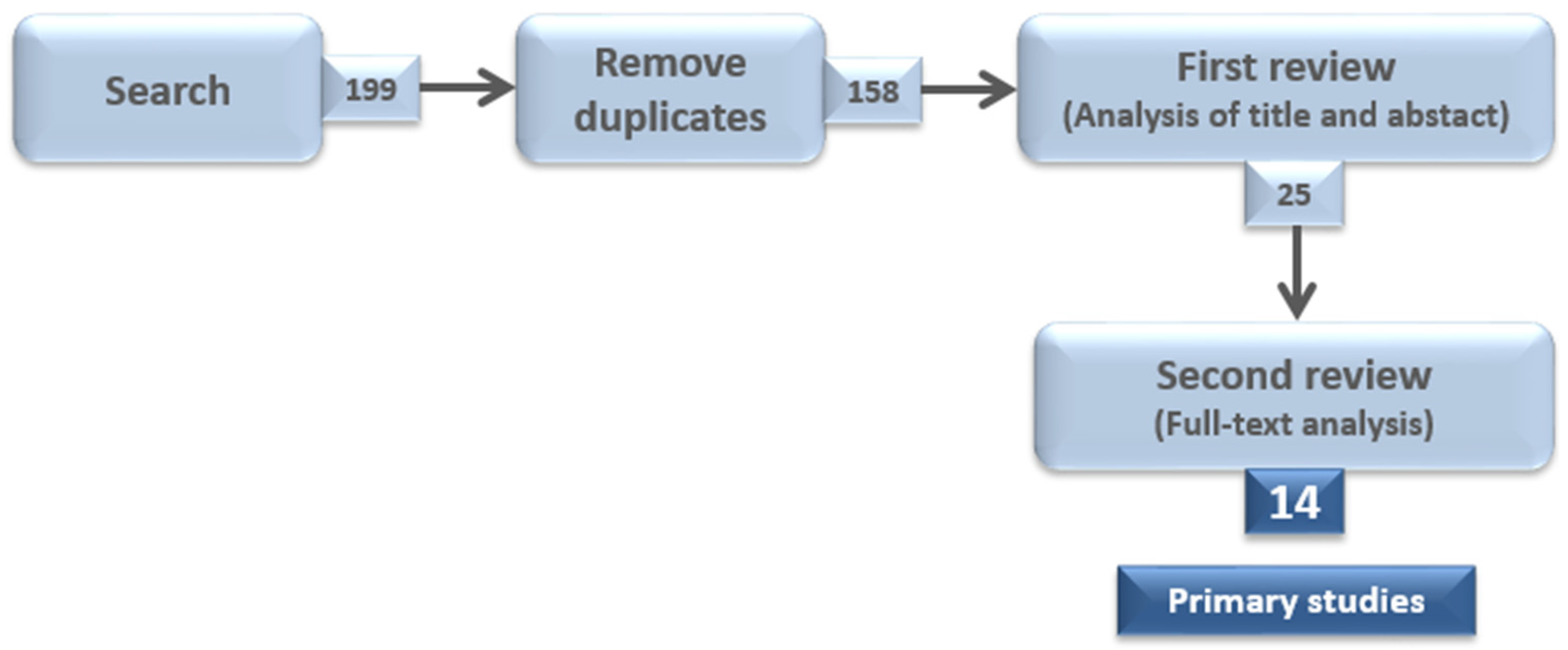
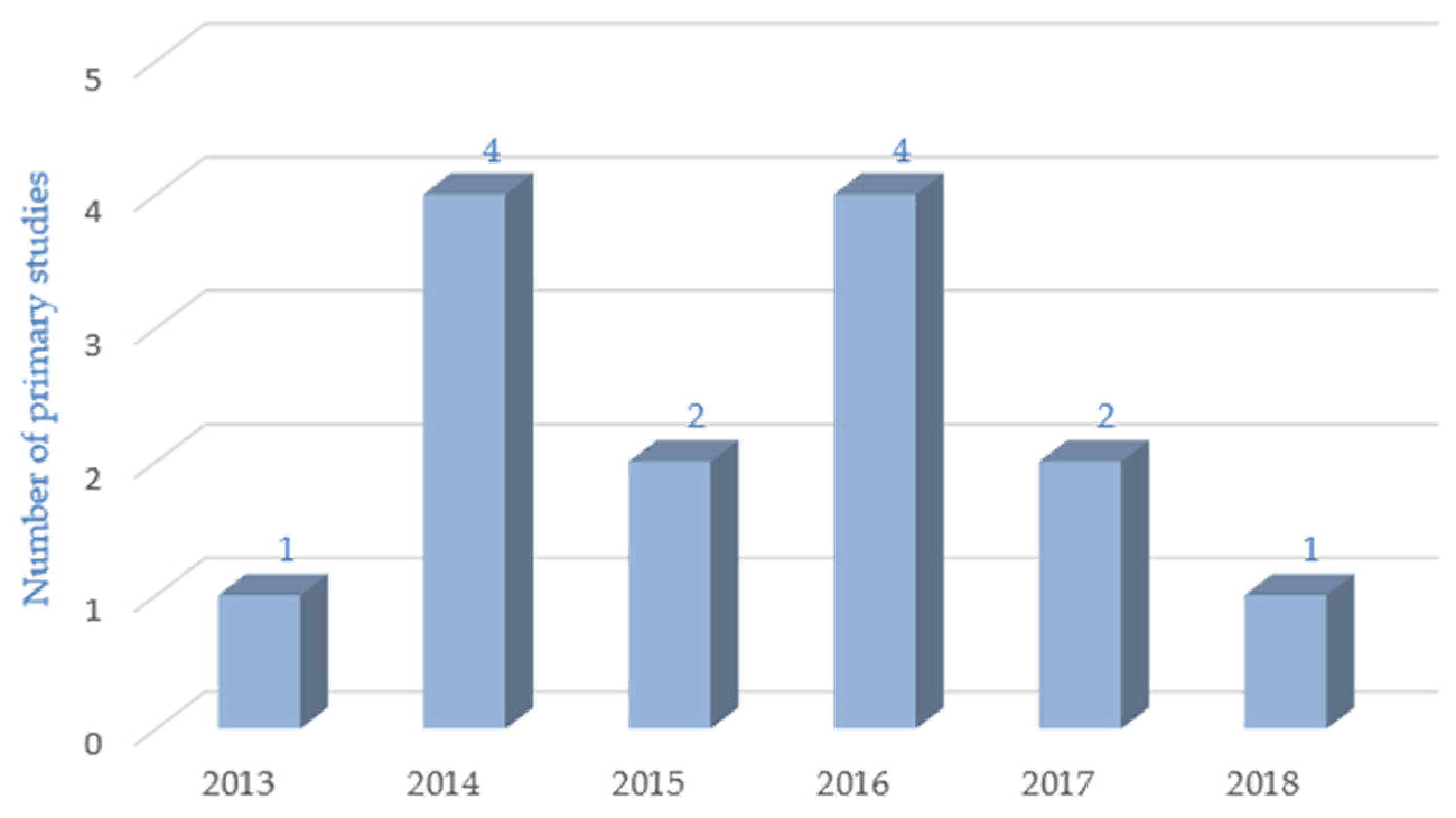
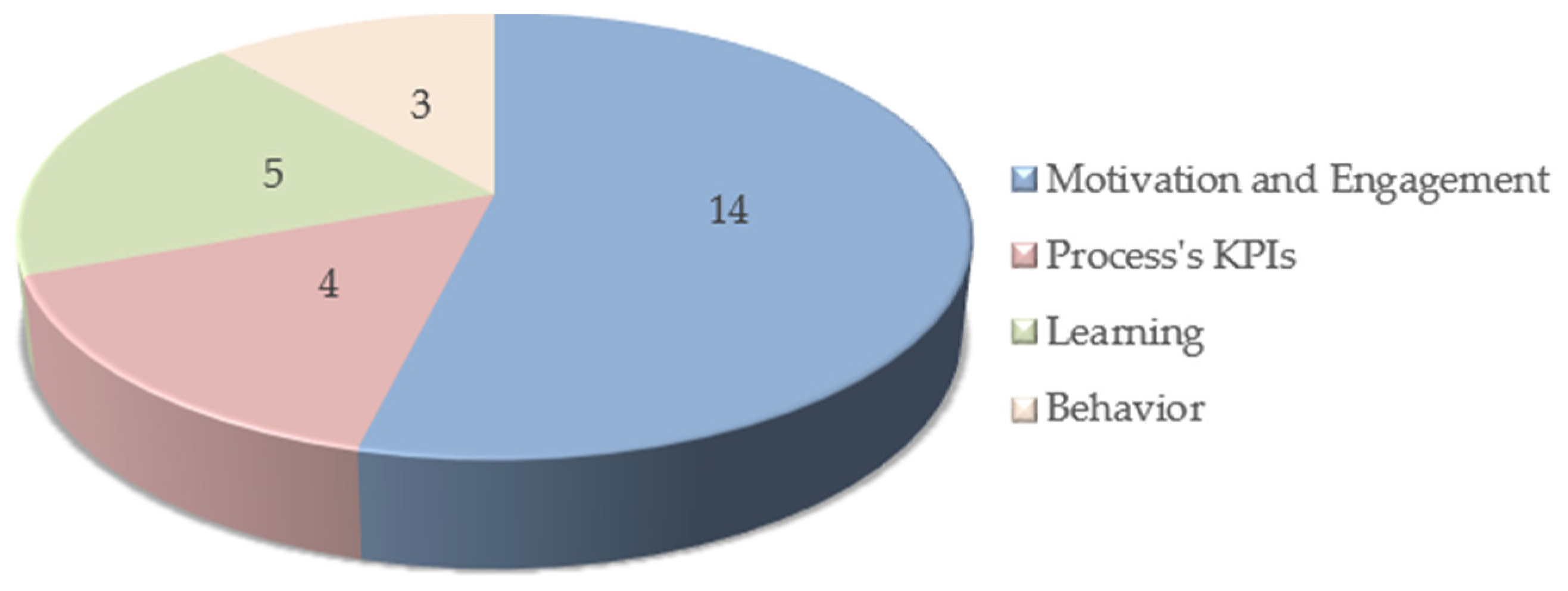
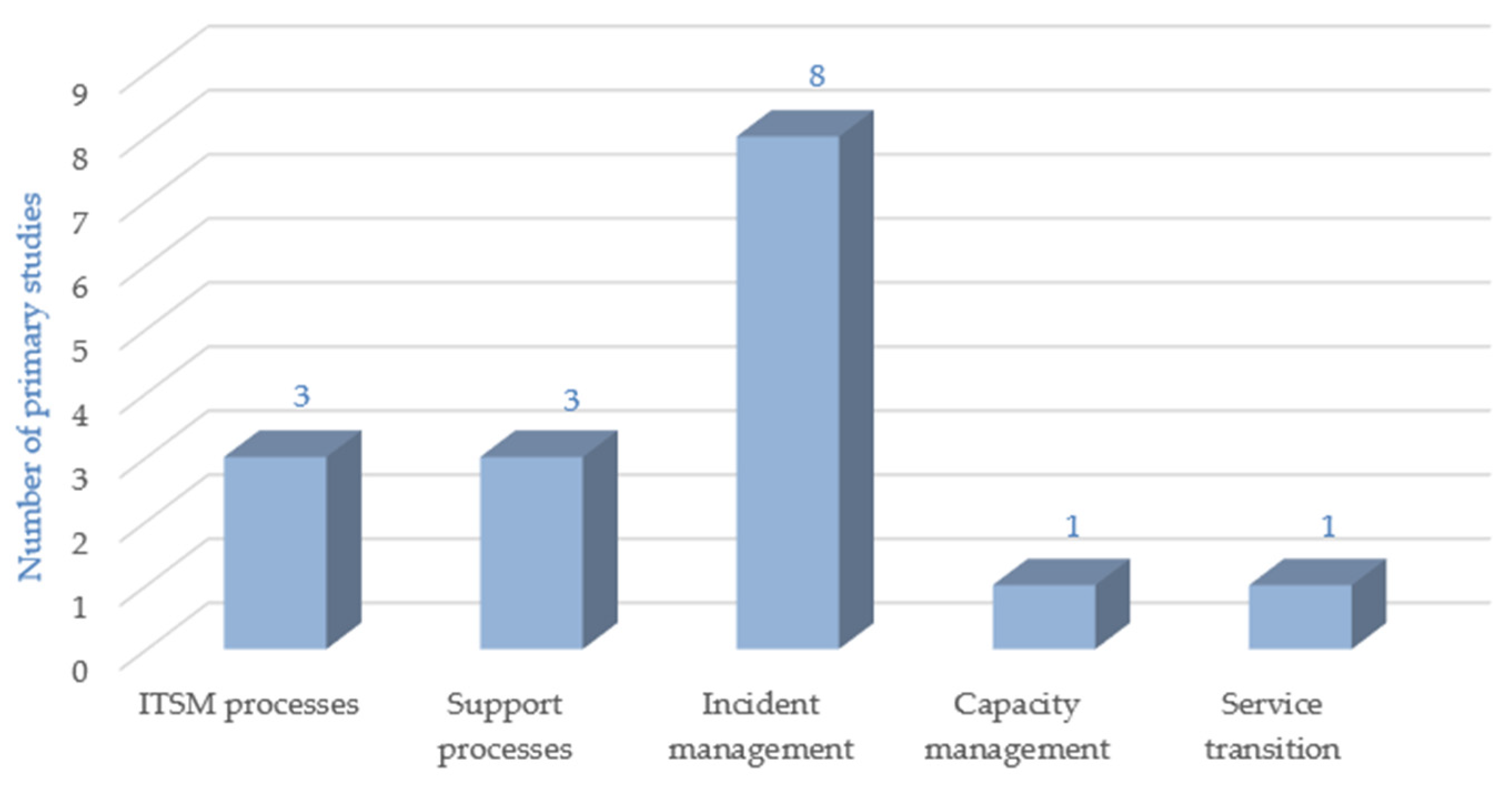
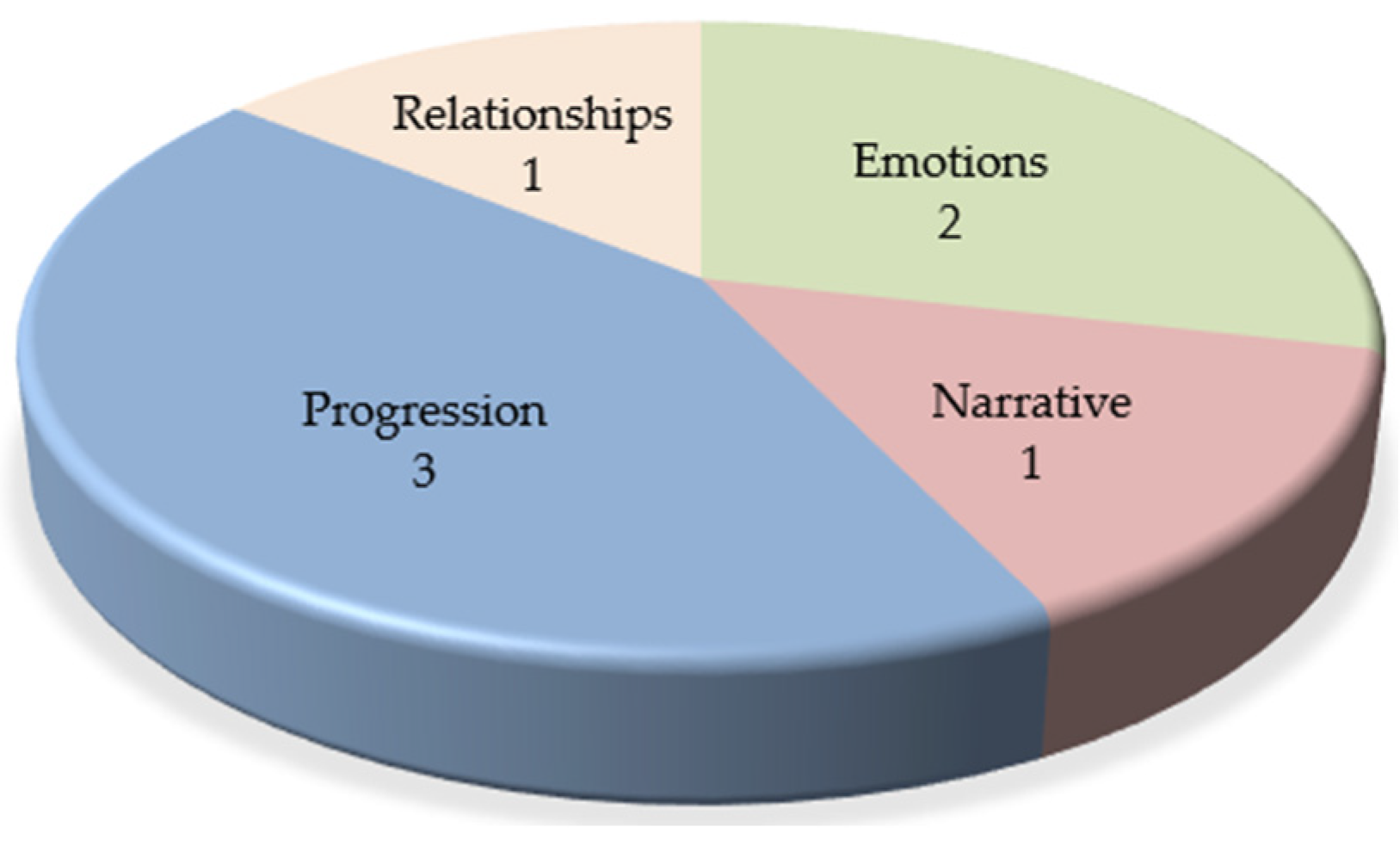
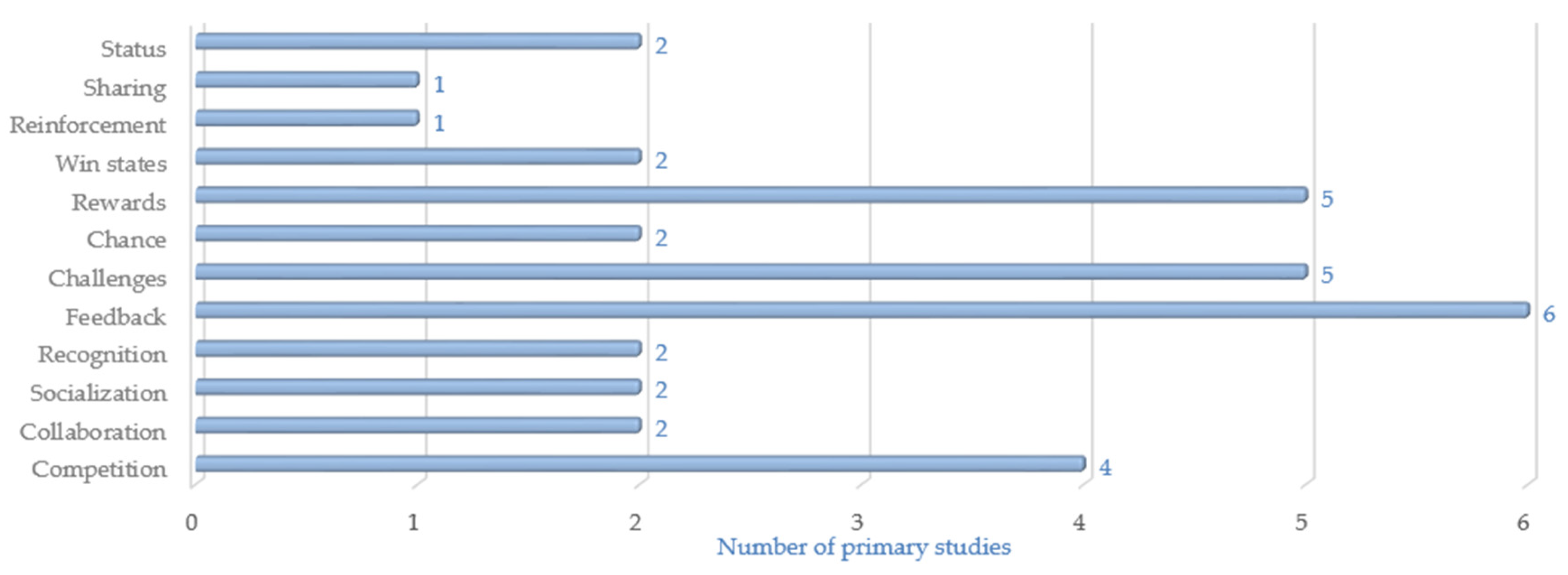
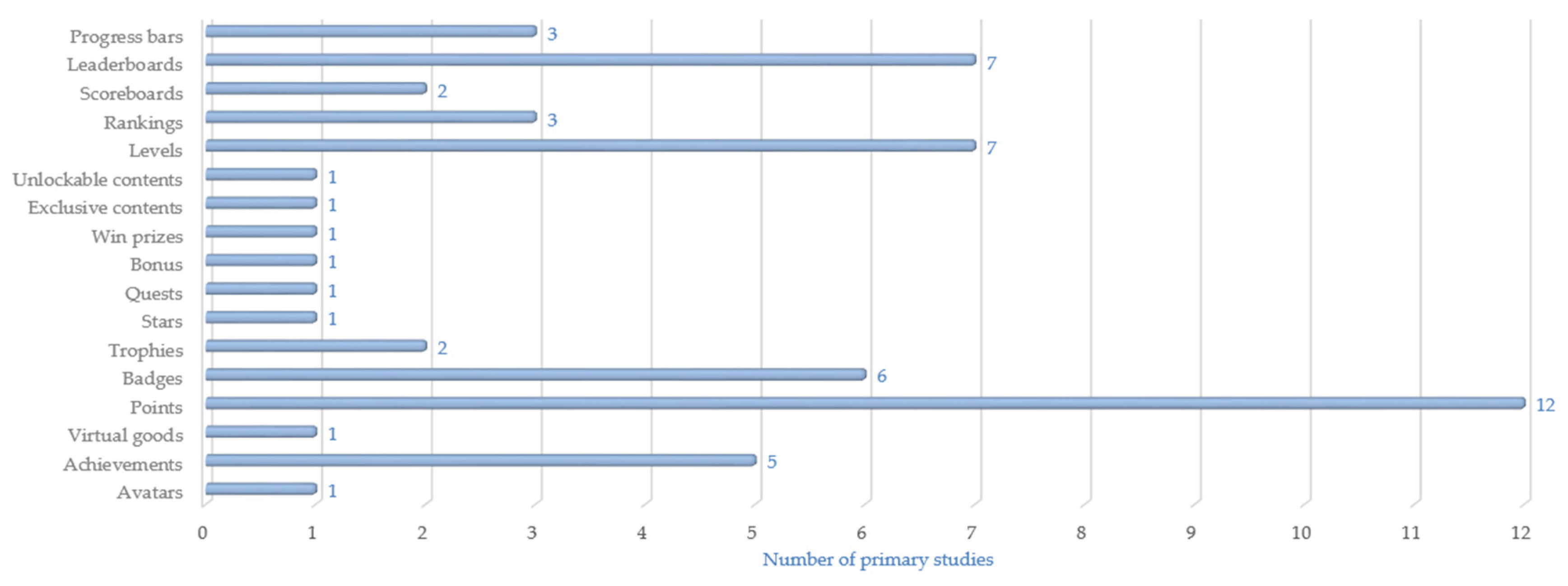
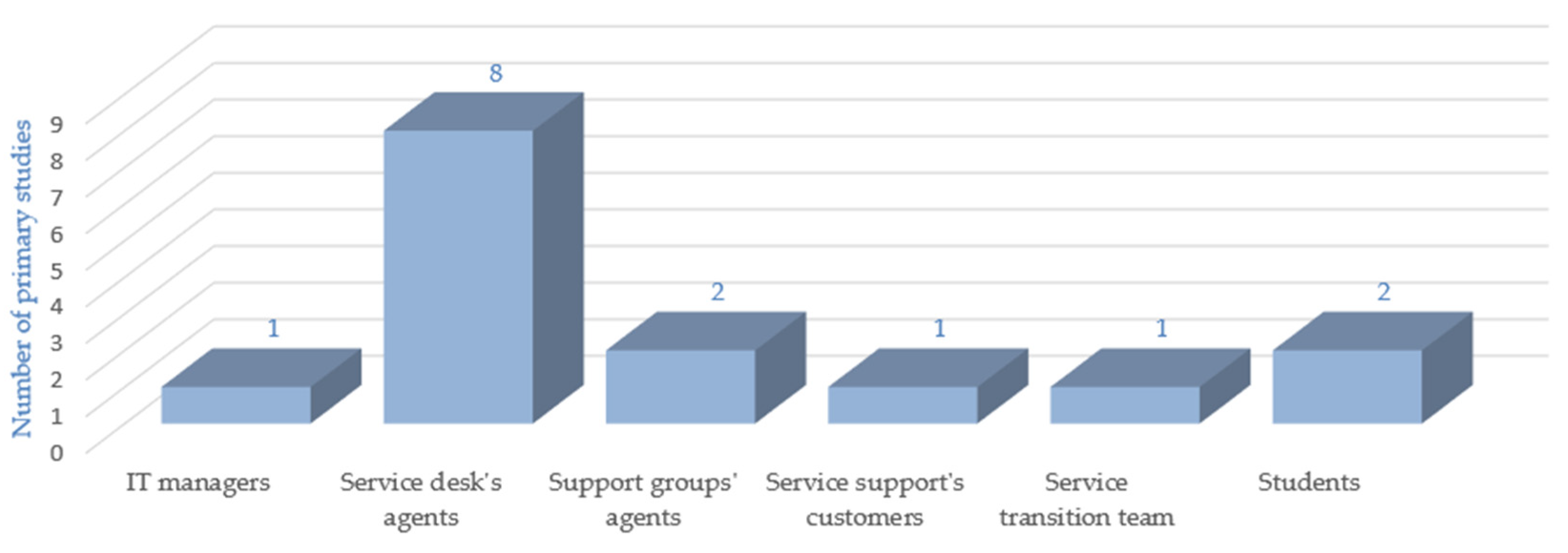
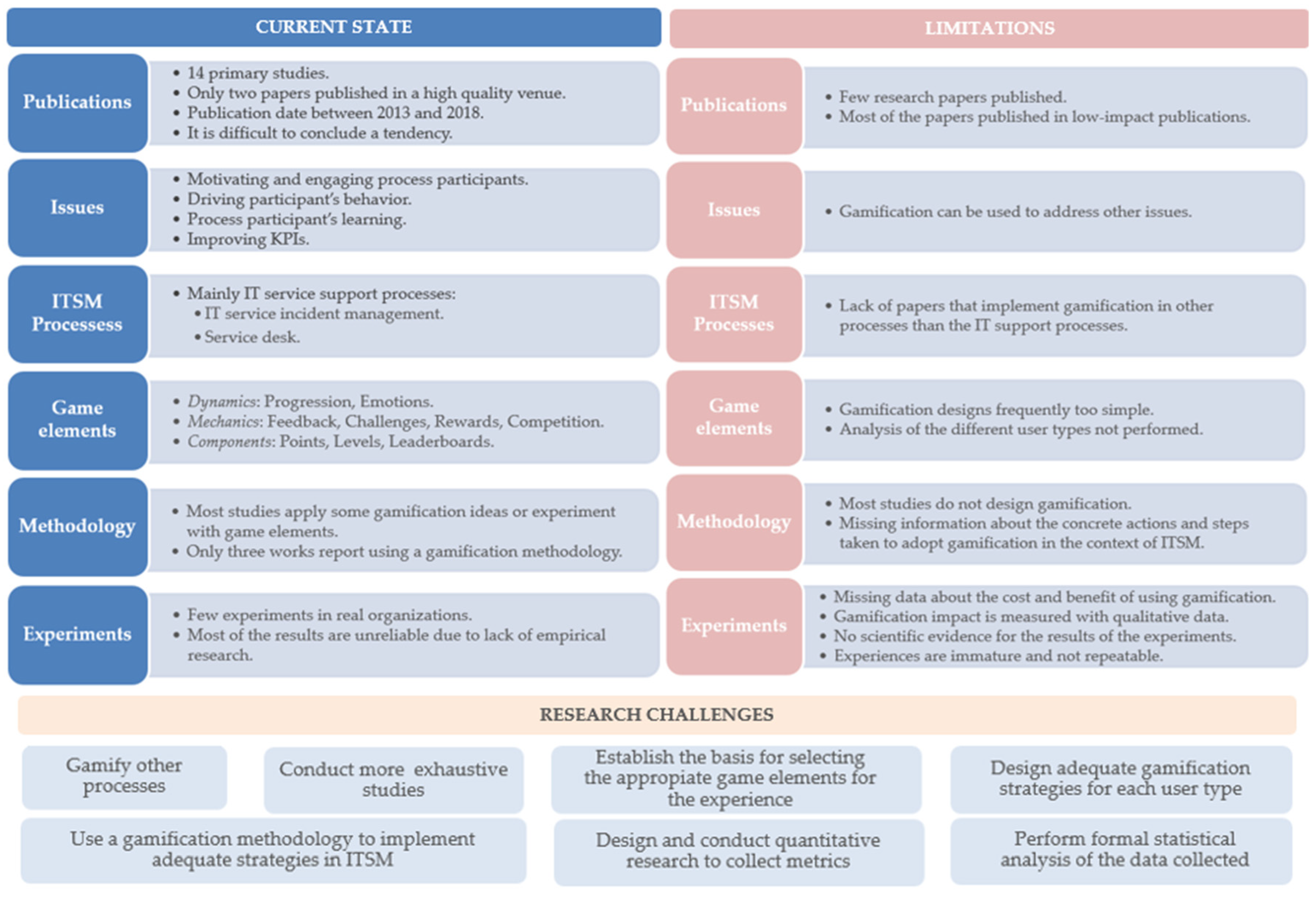
| First Term | Second Term | Third Term |
|---|---|---|
| A1. Gamif* A2. Funware | B1. IT service Management B2. ITSM B3. ITIL | C1. Systematic Review C2. Systematic Literature Review C3. Research Review C4. Systematic Overview C5. Systematic Mapping C6. Mapping Study C7. Systematic Mapping Study C8. Literature Survey |
| ID | Research Question |
|---|---|
| RQ1 | What issues of ITSM process implementation have been addressed through gamification? |
| RQ2 | In which scope of ITSM has gamification been implemented? |
| RQ2.1. Which ITSM frameworks and standards have been used as references in the gamification proposals? | |
| RQ2.2. Which ITSM processes have been addressed by gamification? | |
| RQ3 | How has gamification been implemented in ITSM processes? |
| RQ3.1. Which methods or frameworks have been used to gamify ITSM processes? | |
| RQ3.2. What game elements have been included in the gamified ITSM processes? | |
| RQ3.3 Which tools or platforms have been used to implement the gamified ITSM processes? | |
| RQ3.4. Who are the participants in the gamification proposals? | |
| RQ3.5. How long did the gamification experiences last? How much did the gamification experiences cost? | |
| RQ4 | What is the effect of gamifying ITSM processes? |
First Term | Second Term | |
|---|---|---|
| First Search | Second Search | |
| A1. Gamif* A2. Funware | B1. IT Service Management B2. ITSM B3. IT Management B4. ITIL B5. ISO 20000 B6. ISO/IEC 20000 B7. CMMI-SVC | C1. IT Service Incident C2. IT Service Incidence C3. IT Incident C4. IT Incidence C5. Service Desk C6. Help Desk |
| Primary Sources | Other Sources |
|---|---|
| ACM Digital Library | Google Scholar |
| IEEE Xplore | ORCID |
| Science Direct | ResearchGate |
| SCOPUS | ResearchID |
| SpringerLink | SCOPUS authors details |
| Web of Science |
| Database | Search Results |
|---|---|
| ACM Digital Library | 3 |
| IEEE Xplore | 11 |
| Science Direct | 67 |
| SCOPUS | 30 |
| SpringerLink | 74 |
| Web of Science | 14 |
| Inclusion Criteria |
| Papers published or “in press” in an issue of a journal or the proceedings of a conference or workshop. Publications that introduce a theoretical or practical proposal to gamify ITSM processes. |
| Exclusion Criteria |
| (1) Duplicates. (2) Papers that do not explicitly use gamification in the context of ITSM processes. (3) Papers not written in English. (4) Publications whose full text is not available. (5) Abstracts or reviews of conferences. (6) Reference work entries. (7) Studies that are shorter versions of other studies. |
| Exclusion Criteria | Frequency |
|---|---|
| (1) | 41 |
| (2) | 113 |
| (3) | 23 |
| (4) | 0 |
| (5) | 6 |
| (6) | 0 |
| (7) | 2 |
| Data Item | Value | RQ |
|---|---|---|
| ID | Identifier of the paper. | |
| Title | Name of the paper. | |
| Authors | Name of all the paper’s authors. | |
| Year | Year of publication. | |
| Publication place | Name and quality of the publication place. | |
| Research type | Opinion, personal experiences, philosophical, solution proposal, evaluation research and validation research [80]. | |
| Issues | Issues of ITSM process implementation addressed through gamification. | RQ1 |
| Framework | ITSM reference model used in the study. | RQ2.1 |
| Process | ITSM processes gamified. | RQ2.2 |
| Methodology | Methodology or process followed to gamify ITSM processes. | RQ3.1 |
| Elements | Gamification elements included in the gamified ITSM processes. | RQ3.2 |
| Tools | Tools or technologies used to implement the gamification proposal. | RQ3.3 |
| Participants | Participated in the gamification experiences. | RQ3.4 |
| Duration/Cost | Duration and cost of the gamification experiences. | RQ3.5 |
| Effect | Impact of gamifying ITSM processes. | RQ4 |
| Notes | Any comment about the study that the authors want to record. |
| ID | Year | Publication | Quality |
|---|---|---|---|
| [P01] | 2015 | International Conference on Wireless and Telematics. | – |
| [P02] | 2016 | International Conference on Process Improvement and Capability Determination in Software, Systems Engineering and Service Management. | CORE A |
| [P03] | 2014 | European Conference on Games-based Learning. | – |
| [P04] | 2016 | Indonesian Journal of Electrical Engineering and Computer Science. | – |
| [P05] | 2015 | International Conference on Wireless and Telematics. | – |
| [P06] | 2014 | International Conference on Computer Supported Education. | – |
| [P07] | 2015 | International Conference on HCI in Business. | – |
| [P08] | 2017 | International Conference on Process Improvement and Capability Determination in Software, Systems Engineering and Service Management. | CORE A |
| [P09] | 2013 | International Conference on Human-Computer Interaction, Applications and Services. | – |
| [P10] | 2016 | International Conference on Human Interface and the Management of Information. | – |
| [P11] | 2017 | International Conference on Electrical Engineering and Computer Science. | – |
| [P12] | 2018 | International Journal on Performance Improvement Quarterly. | – |
| [P13] | 2014 | International Conference on the Quality of Information and Communications Technology. | – |
| [P14] | 2015 | International Conference on Games and Learning Alliance. | – |
| Issue | [P01] | [P02] | [P03] | [P04] | [P05] | [P06] | [P07] | [P08] | [P09] | [P10] | [P11] | [P12] | [P13] | [P14] |
|---|---|---|---|---|---|---|---|---|---|---|---|---|---|---|
| Motivation and engagement | x | x | x | x | x | x | x | x | x | x | x | x | x | x |
| Process learning | x | x | x | x | x | |||||||||
| Process KPIs | x | x | x | x | ||||||||||
| User behavior | x | x | x |
| ITSM Processes | Primary Studies |
|---|---|
| No specific process | [P02] [P03] [P14] |
| IT service support processes | [P01] [P04] [P09] |
| IT service incident management process | [P04] [P05] [P07] [P07] [P10] [P11] [P12] [P13] |
| IT service capacity management process | [P02] |
| IT service transition processes | [P06] |
| ID | Method Description | Method Activities |
|---|---|---|
| [P01] | Conceptual framework to gamify ITSM support processes that is a combination of ITIL and a process gamification methodology designed by the authors. | Feasibility study, analysis, design, testing, implementation, monitoring and evaluation. |
| [P02] | Conceptual framework to improve ITSM processes based on building a process simulation model and gamifying the simulation model experimentation. The authors also designed a methodology for gamifying the activity of simulation model experimentation. For this, they used the gamification process designed by Werbach and Hunter [32] as a guideline and adapted it to their case. | Determine business objectives, delineate target behaviors, describe users, devise activity cycles, incorporate fun and deployment appropriate tools. |
| [P08] | Method for gamifying the IT service incident management process that the authors designed adapting the gamification framework proposed by Werbach and Hunter [32] to this context and taking into account ITIL recommendations. | Determine business objectives, delineate target behaviors, describe users, devise activity cycles, incorporate fun and deployment the appropriate tools. |
| Game Elements | [P01] | [P02] | [P03] | [P04] | [P05] | [P06] | [P07] | [P08] | [P09] | [P10] | [P12] | [P13] | [P14] |
|---|---|---|---|---|---|---|---|---|---|---|---|---|---|
| Game dynamics | |||||||||||||
| Emotions | X | X | |||||||||||
| Narrative | X | ||||||||||||
| Progression | X | X | X | ||||||||||
| Relationships | X | ||||||||||||
| Total | 0 | 3 | 0 | 0 | 0 | 0 | 1 | 2 | 0 | 0 | 1 | 0 | 0 |
| Game mechanics | |||||||||||||
| Competition | X | X | X | X | |||||||||
| Collaboration | X | X | |||||||||||
| Socialization | X | X | |||||||||||
| Recognition | X | X | |||||||||||
| Feedback | X | X | X | X | X | X | |||||||
| Challenges | X | X | X | X | X | ||||||||
| Chance | X | X | |||||||||||
| Rewards | X | X | X | X | X | ||||||||
| Win states | X | X | |||||||||||
| Reinforcement | X | ||||||||||||
| Sharing | X | ||||||||||||
| Status | X | X | |||||||||||
| Total | 0 | 5 | 3 | 2 | 1 | 0 | 8 | 4 | 3 | 4 | 3 | 0 | 1 |
| Game components | |||||||||||||
| Avatars | X | ||||||||||||
| Achievements | X | X | X | X | |||||||||
| Virtual goods | X | ||||||||||||
| Points | X | X | X | X | X | X | X | X | X | X | X | X | |
| Badges | X | X | X | X | X | X | X | ||||||
| Trophies | X | X | |||||||||||
| Stars | X | ||||||||||||
| Quests | X | ||||||||||||
| Bonus | X | ||||||||||||
| Win prizes | X | ||||||||||||
| Exclusive contents | X | ||||||||||||
| Unlockable contents | X | ||||||||||||
| Levels | X | X | X | X | X | X | X | X | X | ||||
| Rankings | X | X | X | ||||||||||
| Scoreboards | X | X | |||||||||||
| Leaderboards | X | X | X | X | X | X | X | ||||||
| Progress bars | X | X | X | ||||||||||
| Total | 1 | 8 | 4 | 7 | 2 | 3 | 8 | 5 | 4 | 4 | 7 | 1 | 4 |
| ID | Experience Duration |
|---|---|
| [P03] [P14] | 105 days |
| [P04] | 9 days |
| [P11] | 4 days |
| [P12] | 105 days |
| ID | Research Type | Evaluation Method | Reported Gamification Impact |
|---|---|---|---|
| [P01] | Philosophical |
|
|
| [P02] | Philosophical |
|
|
| [P03] | Evaluation |
|
|
| [P04] | Evaluation |
|
|
| [P05] | Philosophical |
|
|
| [P06] | Evaluation |
|
|
| [P07] | Evaluation |
|
|
| [P08] | Philosophical |
|
|
| [P09] | Opinion |
|
|
| [P10] |
|
| |
| [P11] | Evaluation |
|
|
| [P12] | Evaluation |
|
|
| [P13] | Evaluation |
|
|
| [P14] | Evaluation |
|
|
Publisher’s Note: MDPI stays neutral with regard to jurisdictional claims in published maps and institutional affiliations. |
© 2021 by the authors. Licensee MDPI, Basel, Switzerland. This article is an open access article distributed under the terms and conditions of the Creative Commons Attribution (CC BY) license (https://creativecommons.org/licenses/by/4.0/).
Share and Cite
Trinidad, M.; Orta, E.; Ruiz, M. Gamification in IT Service Management: A Systematic Mapping Study. Appl. Sci. 2021, 11, 3384. https://doi.org/10.3390/app11083384
Trinidad M, Orta E, Ruiz M. Gamification in IT Service Management: A Systematic Mapping Study. Applied Sciences. 2021; 11(8):3384. https://doi.org/10.3390/app11083384
Chicago/Turabian StyleTrinidad, Manuel, Elena Orta, and Mercedes Ruiz. 2021. "Gamification in IT Service Management: A Systematic Mapping Study" Applied Sciences 11, no. 8: 3384. https://doi.org/10.3390/app11083384
APA StyleTrinidad, M., Orta, E., & Ruiz, M. (2021). Gamification in IT Service Management: A Systematic Mapping Study. Applied Sciences, 11(8), 3384. https://doi.org/10.3390/app11083384






